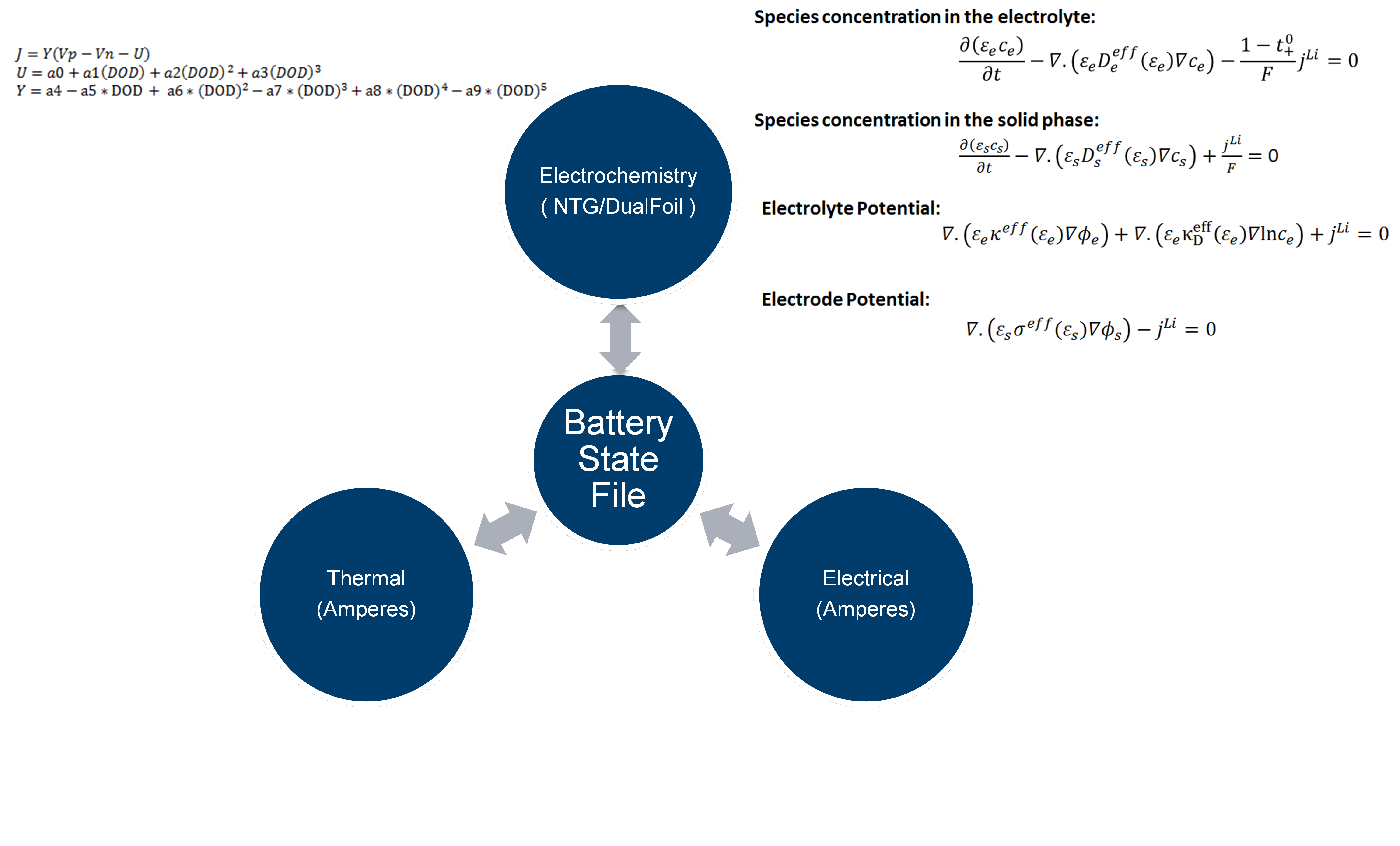Battery Markup Language (BatML) Standard
Computational Models for Batteries
The OAS framework integrates battery models using component and state adapters. The component adapters interact with the components by preparing the necessary inputs to run the components and by scheduling the component runs. The state adapters interact with the battery state file(s) by updating all the necessary information about the battery state and the methods for coupling the components. Fig. 1 shows a battery state file that transfers the information between the electrochemistry, thermal and electrical physics components. The device hierarchy is modeled by coarse-graining of the underlying sub-components. The top hierarchical level of the model is divided into zones. These zones then transfer information between the components in case of loosely coupled multi-physics simulations.

Figure 1: Battery state file – passing data between components
Currently Implemented Models
We have added several components for modeling electrochemistry and mass, electron, and heat transport into VIBE (Virtual Integrated Battery Environment). The components that have been integrated so far are:
-
Electrochemistry
-
Dual-Foil ( Doyle, Fuller et al. 1993; Fuller, Doyle et al. 1994; Fuller, Doyle et al. 1994 )
-
NTG ( Seong Kim, Yi et al. 2011 )
-
NTG automated process from discharge curves (to be completed by December 2012)
-
NREL MSMD (Initial) ( Kim, Smith et al. 2011 )
-
AMPERES Single Particle (to be completed by December 2012)
-
-
Thermal
-
AMPERES
-
-
Electrical
-
AMPERES
-
-
Cost Model
-
ANL Cost Model (to be completed by December 2012)
-
In FY13, we will expand VIBE with additional components from the three CAEBAT partners, other National laboratories and universities. In the Examples section, you can find examples that primarily consider model coupling between the cell and cell-sandwich. These examples were selected in order to demonstrate the VIBE capability and flexibility. In FY13 we will perform some detailed validation and coupling to module and pack.
References
-
Doyle, M., T. F. Fuller, et al. (1993). "Modeling of Galvanostatic Charge and Discharge of the Lithium/Polymer/Insertion Cell." Journal of the Electrochemical Society 140(6): 1526-1533.
-
Fuller, T. F., M. Doyle, et al. (1994). "Relaxation Phenomena in Lithium-Ion-Insertion Cells." Journal of the Electrochemical Society 141(4): 982-990.
-
Fuller, T. F., M. Doyle, et al. (1994). "Simulation and Optimization of the Dual Lithium Ion Insertion Cell." Journal of the Electrochemical Society 141(1): 1-10.
-
Kim, G.-H., K. Smith, et al. (2011). "Multi-Domain Modeling of Lithium-Ion Batteries Encompassing Multi-Physics in Varied Length Scales." Journal of the Electrochemical Society 158(8): A955-A969.
-
Seong Kim, U., J. Yi, et al. (2011). "Modeling the Dependence of the Discharge Behavior of a Lithium-Ion Battery on the Environmental Temperature." Journal of the Electrochemical Society 158(5): A611-A618.
-
Srinivasan, V. and C. Y. Wang (2003). "Analysis of Electrochemical and Thermal Behavior of Li-Ion Cells." Journal of the Electrochemical Society 150(1): A98-A106.
-
"BatPac."website